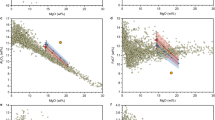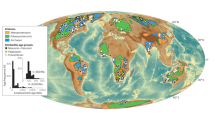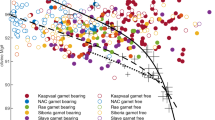Abstract
THE genesis of a wide spectrum of basaltic magmas by partial melting of a peridotitic upper mantle with small amounts of H2O as its only volatile component is well established1–3, as is the role of CO2 in magma genesis in the upper mantle4,5. However, the origin of K-rich mafic to ultramafic magmas has not been satisfactorily explained by mechanisms involving partial melting of commonly accepted upper mantle sources. We report here experiments on an olivine ugandite from Bufumbira, south-west Uganda6, in conditions of H2O and H2O–CO2 mixtures ( ∼0.75) up to 40 kbar, and at an ⩾Ni–NiO buffer7. These are the first experiments reported on a lava of the ultramafic alkaline type with K2O > Na2O using both H2O and CO2 as volatiles and showing that K-rich ultramafic magmas can be derived by partial melting of a ‘normal’ peridotitic mantle containing both H2O and CO2. Olivine ugandite is believed to be the most primitive lava occurring in this K-rich province6,8–10 and may reasonably be considered as a model composition for K-rich ultramafic magmas generally.
This is a preview of subscription content, access via your institution
Access options
Subscribe to this journal
Receive 51 print issues and online access
$199.00 per year
only $3.90 per issue
Buy this article
- Purchase on Springer Link
- Instant access to full article PDF
Prices may be subject to local taxes which are calculated during checkout
Similar content being viewed by others
References
Green, D. H. Trans. Leicester lit. phil. Soc. 64, 28–54 (1970).
Green, D. H. Tectonophysics 13, 47–71 (1972).
Green, D. H. Earth planet. Sci. Lett. 19, 37–53 (1973).
Eggler, D. H. Geology 4, 69–72 (1976).
Wyllie, P. J. in High Pressure Research (eds Manghnami, M. H. & Akimoto, S.) 77 (Academic, New York, 1977).
Holmes, A. & Harwood, F. Mem. geol. Surv. Uganda 3, part 2 (1937).
Brey, G. & Green, D. H. Contr. Miner. Petrol. 61, 141–162 (1977).
Holmes, A. Am. Miner. 35, 772–792 (1950).
Cundari, A. & Le Maitre, R. W. J. Petrol. 11, 33–47 (1970).
Ferguson, A. K. & Cundari, A. Contr. Miner. Petrol. 50, 25–46 (1975).
Brey, G. & Green, D. H. Contr. Miner. Petrol. 49, 93–103 (1975).
Brey, G. & Green, D. H. Contr. Miner. Petrol. 55, 217–230 (1976).
Edgar, A. D., Green, D. H. & Hibberson, W. O. J. Petrol. 17, 339–356 (1976).
Bailey, D. K. J. geophys. Res. 69, 1103–1111 (1964).
Eggler, D. H., Holloway, J. R. & Mysen, B. O. Geology, 4, 198–199 (1976).
Carmichael, I. S. E. Contr. Miner. Petrol. 15, 24–66 (1967).
Author information
Authors and Affiliations
Rights and permissions
About this article
Cite this article
EDGAR, A., CONDLIFFE, E. Derivation of K-rich ultramafic magmas from a peridotitic mantle source. Nature 275, 639–640 (1978). https://doi.org/10.1038/275639a0
Received:
Accepted:
Issue Date:
DOI: https://doi.org/10.1038/275639a0
This article is cited by
-
Phlogopite- and clinopyroxene-dominated fractional crystallization of an alkaline primitive melt: petrology and mineral chemistry of the Dariv Igneous Complex, Western Mongolia
Contributions to Mineralogy and Petrology (2014)
-
Fractional crystallization of high-K arc magmas: biotite- versus amphibole-dominated fractionation series in the Dariv Igneous Complex, Western Mongolia
Contributions to Mineralogy and Petrology (2014)
-
Melting phase relations of a mica–clinopyroxenite from the Milk River area, southern Alberta, Canada
Contributions to Mineralogy and Petrology (2013)
-
An experimental study of a minette from the Milk River area, southern Alberta, Canada
Contributions to Mineralogy and Petrology (2012)
-
The last lavas erupted during the main phase of the Siberian flood volcanic province: results from experimental petrology
Contributions to Mineralogy and Petrology (2006)
Comments
By submitting a comment you agree to abide by our Terms and Community Guidelines. If you find something abusive or that does not comply with our terms or guidelines please flag it as inappropriate.



